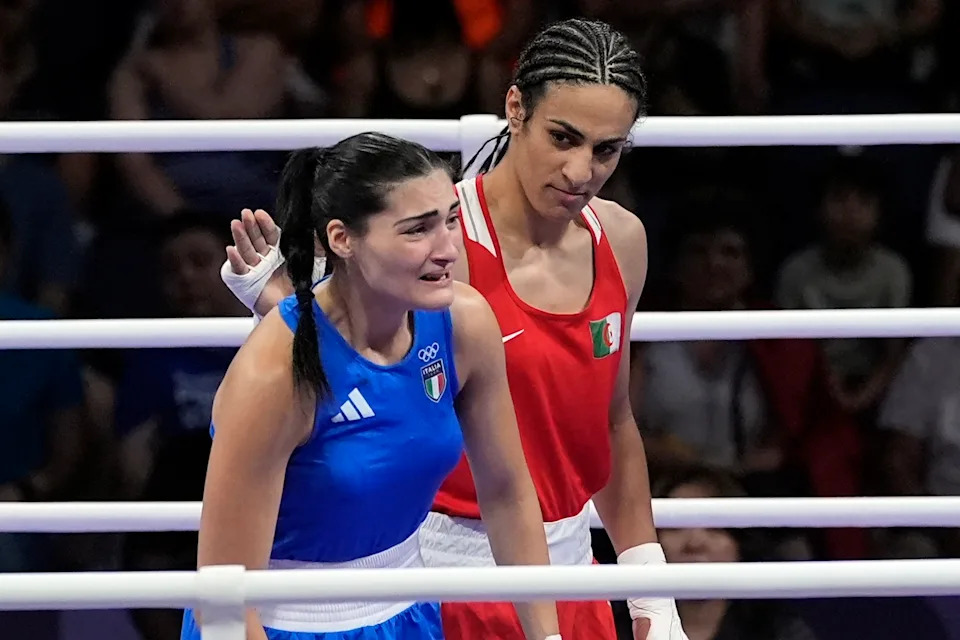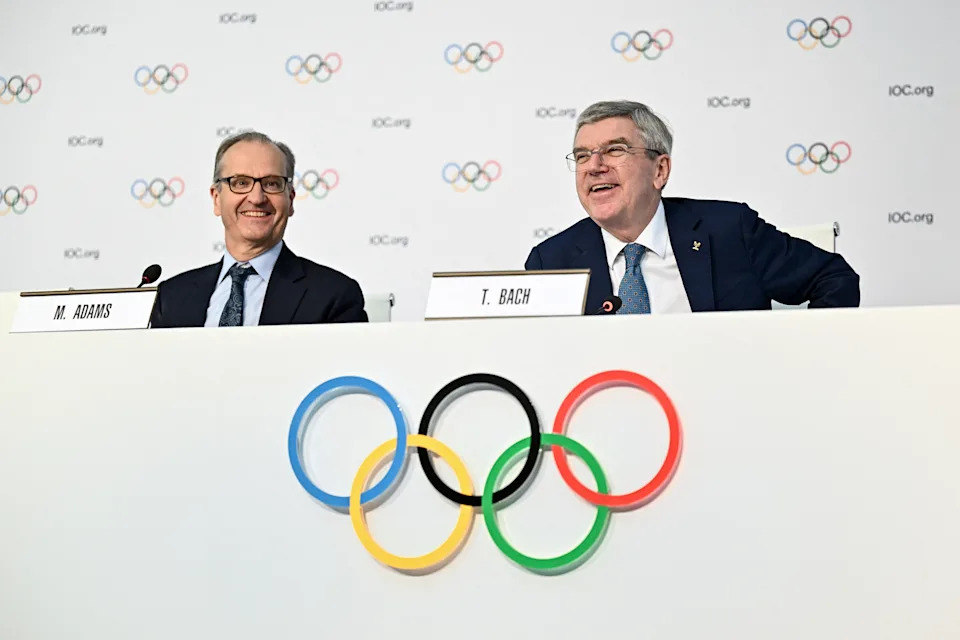Less than a week before Imane Khelif was poised to return to competitive women’s boxing, the sport’s new global governing body set up a potential roadblock.
World Boxing announced last Friday that Khelif cannot participate in any future women’s events unless the Olympic champion takes a gender verification test to prove that Khelif is biologically female.
Advertisement
The International Olympic Committee ignited global outcry in Paris last summer when it allowed Khelif to march to a gold medal in the women’s welterweight division. Only a year earlier, Khelif was disqualified before the gold-medal bout of the International Boxing Association’s world championships. The IBA, then recognized as amateur boxing’s global governing body, claimed that a sex test showed the presence of Y chromosome and ruled Khelif ineligible to compete against women.
Three months later, the IOC stripped the IBA of its governing status for a number of reasons, after which IOC leaders chose to overlook Khelif’s alleged failed gender test because they had questions about the fairness of the IAB’s process. That turned the IOC into a piñata for critics at last summer’s Olympic Games as , then toyed with her remaining opponents while displaying superior reach and punching power.
In February, the IOC recognized World Boxing as its new governing body for the sport — and assessing how to be fair to both Khelif and her potential female opponents instantly moved atop World Boxing’s to-do list. The solution that World Boxing chose was making sex testing mandatory for all boxers who compete in events it sanctions. The organization announced the policy change ahead of this week’s Eindhoven Box Cup to get ahead of the tournament Khelif was targeting for her potential return.
Assessing how to be fair to both Khelif and her potential female opponents was atop World Boxing’s to-do list after the IOC provisionally recognized it as the sport’s governing body earlier this year. The solution that World Boxing chose was making sex testing mandatory for all boxers who compete in events it sanctions. The organization announced the policy change ahead of this week’s Eindhoven Box Cup to get ahead of the tournament Khelif was targeting for her potential return.
Advertisement
“This decision reflects concerns over the safety and well-being of all boxers, including Imane Khelif,” World Boxing said in last Friday’s statement. “It aims to protect the physical and mental health of all participants in light of some of the reactions that have been expressed in relation to the boxer’s potential participation at the Eindhoven Box Cup.”
The Khelif controversy exemplifies why dividing athletes into male and female categories for competition isn’t always straightforward. Gender policing has existed in women’s sports for nearly a century as administrators have grappled with deliberate cheating, transgender athletes and complex medical conditions resulting in ambiguous development of sex organs.
Sports governing bodies have used anything from invasive visual examinations, to testosterone tests, to chromosome analyses in their long-running attempts to distinguish men from women. The most common outcome has been humiliation for female athletes confronted for the first time with the possibility that their genitalia, internal anatomy, hormones or chromosomes developed differently than most of their peers.
That presents a conundrum for sporting governing bodies: How should they treat an athlete who was classified female at birth and identifies as a woman yet possesses a Y chromosome? How should they handle it when that athlete’s differences in sexual development offer a potential advantage in sporting performance over other female competitors?
Advertisement
Dr. Richard Holt, professor of endocrinology at the University of Southampton, describes that decision as a “minefield.”
Says Holt, “There is no easy solution — all have potential pitfalls.”
Helen Stephens smiles for the camera man after setting a new world record in the 100 meter finals at the 1936 Olympics in Berlin. (Getty Images)
(Bettmann via Getty Images)
‘The Nude Parade’
The desire to define who counts as a woman for the purpose of sports dates all the way back to Hitler’s Olympics. On the night of August 4, 1936, a Missouri farm girl named Helen Stephens went to bed the newly crowned fastest woman in the world. The next morning, Stephens awoke to an international firestorm.
A Polish newspaper correspondent could not accept that Stephens had defeated famed Polish sprinter Stella Walsh to win Olympic gold in the 100-meter dash. He published a story discrediting Stephens’ world record performance by alleging that the tall, muscular American with an unusually deep voice was really a man masquerading as a woman.
Advertisement
Rather than dismissing the Polish sportswriter’s accusation as the sour grapes, Olympic officials responded by revealing that they had anticipated such a controversy. They before the Olympics and cleared her to compete after confirming that she was female.
At least one U.S. media outlet reached out to Stephens’ mother seeking her response to the speculation about her daughter’s gender.
“Helen is absolutely a girl,” Bertie May Stephens , adding that she better not say what she thinks of “anyone who would charge that she is anything else.”
The scandal reflected the growing unease at the time over the physical appearance of female athletes enjoying success in sports once deemed too strenuous for women. They were often perceived as suspiciously masculine because they didn’t conform to the era’s notion of femininity.
Advertisement
In early 1936, American Olympic Committee chairman Avery Brundage wrote to IOC colleagues expressing concern about “various female (?) athletes in several sports” who seemed to possess “apparent characteristics of the opposite sex.”
“Perhaps some action has already been taken on this subject,” Brundage added. “If not, it might be well to insist on a medical examination before participation in the Olympic Games.”
The first known gender verification rule in women’s sports took effect less than a week after Stephens’ gold medal win in Berlin. Track and field’s international governing body implemented a policy requiring female athletes to submit to physical examination should any protest be filed regarding their sex.
When the Olympics first became a stage for Cold War tensions in the 1950s, familiar concerns about female athletes deemed too man-like suddenly were seen through a geopolitical lens. Rumors flew that the brawniest female athletes from the Soviet Union and other Eastern-bloc nations were taking performance-enhancing drugs or were actually men in disguise.
Advertisement
Soviet track and field stars Irina and Tamara Press, sisters who combined to claim five Olympic gold medals and set 26 world records, aroused the most suspicion. Western media outlets derisively labeled Irina and Tamara “the Press brothers.” In 1964, a New York Times reporter wrote that Tamara
In 1966, international track and field officials responded by enforcing a mandatory sex testing policy often referred to by athletes as “the nude parade.” Every female participant at that year’s Commonwealth Games had to undress on-site before the meet and display themselves to doctors for visual inspection.
Irina and Tamara Press hung up their track spikes and retired. Other athletes gritted their teeth and endured the humiliation. In last year, Canadian discus thrower Carol Martin described being taken into a large room underneath the stands and having “to pull my pants down in front of this woman so she could see I had a vagina.”
“I remember thinking, ‘What the [expletive] is this?’” Martin told the podcast. “And I was a nice person. I never said that at the time, but I remember thinking, ‘Whoa, this seems a little invasive. This seems a little inappropriate. I mean, can’t you see I’m a girl?’”
Advertisement
Nude parades, unsurprisingly, proved deeply unpopular. Athletes successfully campaigned to abolish the practice after only two years.

Algeria’s Imane Khelif, right, looks at Italy’s Angela Carini, following their women’s 66kg preliminary boxing match at the 2024 Summer Olympics. Carini abandoned the fight after just 46 seconds. (AP Photo/John Locher, File)
(ASSOCIATED PRESS)
‘There’s definitely not an easy solution’
Modern methods of sex testing may only require a swab to the cheek or a few drops of blood, but critics contend they’re still traumatic.
Athletes rights advocate and Humans of Sport founder Payoshni Mitra has worked on behalf of numerous high-profile athletes revealed to have unusually high testosterone levels. Some battled through severe depression, Mitra said. One family even lost their daughter to suicide.
About a decade and a half ago, Caster Semenya became the unwilling face of a complex, emotionally charged debate over what to do with athletes who don’t fit neatly in the “male” or “female” category. The muscular South African middle-distance star blew away the women’s 800 meters field at the 2009 World Championships, but she couldn’t outrun the whispers and innuendo that followed.
Advertisement
“For me she is not a woman,” said one beaten fellow finalist, Italy’s Elisa Cusma Piccione.
Another overmatched rival, Russia’s Mariya Savinova, sneered, “Just look at her.”
At the request of track and field’s governing body, Semenya submitted to a gender verification test and found out along with the rest of the world that she was different. While Semenya was born with a vagina and assigned female at birth, her test results showed XY chromosomes, no uterus and unusually high testosterone levels.
Stunned and devastated, Semenya weighed her options. Either she had to quit track at age 18 on the heels of winning World Championship gold or consent to hormone treatment to lower her testosterone to a predetermined level.
Advertisement
The hormones felt like “poison,” Semenya wrote in her 2023 memoir “The Race To Be Myself,” but she fought through panic attacks, night sweats and nausea to keep flourishing. Second place finishes at the 2011 World Championships and the 2012 Olympics were later upgraded to gold medals when Savinova was found guilty of doping. Semenya also led a podium sweep by DSD runners at the 2016 Olympics after the Court of Arbitration for Sport temporarily forced World Athletics to suspend its testosterone regulations.
On the eve of the 2016 Olympic fina in the women’s 800, Yahoo Sports asked American 800-meter runner Ajee’ Wilson how she felt about Semenya. Should Semenya be free to compete without being forced to take testosterone suppressants? Or should her basic rights be infringed on to avoid unfairly disadvantaging the other female competitors?
“There’s definitely not an easy solution,” Wilson conceded. “There’s a saying that says you shouldn’t really come hard at a problem unless you have a solution. I don’t have one at this point, so I have to go with the flow of things.”
While World Athletics now administers gender tests to all female athletes, from 1999 to 2024, track and field’s governing body only tested targets of suspicion. Human Rights Watch condemned that approach in 2020, pointing out that the athletes being ensnared by sex testing were “overwhelmingly women of color from the Global South.”
Advertisement
Among those is Annet Negesa, a promising Ugandan middle-distance runner targeted under sex testing regulations and found to have unusually high testosterone levels. Negesa agreed to undergo what she was told was minor surgery in late 2012 in hopes of altering her body and saving her career.
When she awoke in a hospital bed, she that she had scars on her belly and discharge papers mentioning an orchiectomy — a procedure to remove testicles. The recovery from the surgery was long and painful. Never again did Negesa regain her previous fitness levels. Her manager dropped her and her university yanked away her scholarship.
Today Negesa lives in Germany, where she was granted asylum in 1999. The athlete ambassador to Humans of Sport shares her story as often as possible in hopes that it can help others. She has been following Imane Khelif’s story from afar.
“I am extremely disappointed to see how another athlete from a different sport is being made to face such a public trial,” Negesa said this week in a statement to Yahoo Sports. “It is devastating for the athlete. Federations must act responsibly. They have played with our lives for too long.”

Both IOC president Thomas Bach (R) and IOC spokesman Mark Adams defended the IOC’s decision to allow Imane Khelif to participate in the Paris Olympics, calling tests that showed Khelif has a male karyotype not legitimate. (Fabrice Coffrini/AFP via Getty Images)
(FABRICE COFFRINI via Getty Images)
IOC has egg on its face
Thirty-six hours after World Boxing ruled that Khelif would need to pass a gender verification test to be eligible to fight against women again, the document at the heart of this entire saga may have surfaced.
Advertisement
American sportswriter Alan Abrahamson, formerly of the Los Angeles Times, what appears to be a leaked image of Khelif’s sex-test results from the 2023 IBA world championships in New Delhi.
The chromosome analysis says that Khelif has a “male karyotype” (an individual’s complete set of chromosomes). IBA officials had previously alleged without offering proof that Khelif was XY.
It’s unclear how Abrahamson attained the apparent leaked document or whether it is legitimate. Neither Khelif nor anyone with the Algerian Boxing Federation have publicly addressed the report or World Boxing’s mandatory sex testing policy.
The test results carry the letterhead of Dr Lal Path Labs in New Delhi, accredited by the American College of Pathologists and certified by the Swiss-based International Organisation for Standardisation. That appears to fly in the face of claims made last August by IOC spokesman Mark Adams, who during a news conference at the Paris Olympics took the stance that any test administered by the IBA was essentially fruit from a poison tree.
Advertisement
“The tests themselves, the process of the tests, the ad hoc nature of the tests, are not legitimate,” Adams said.
Also left with egg on his face is IOC president Thomas Bach, who several times insinuated that the Khelif test results were part of a Russian disinformation campaign. The IBA is run by Umar Kremlev, a Russian businessman with close ties to the Kremlin.
“This was part of the many, many fake news campaigns we had to face from Russia before Paris and after Paris,” Bach told Reuters last March.
If the leaked test results put pressure on IOC officials to explain why they believe they’re illegitimate, they also increase the burden on Khelif to make a public comment.
Advertisement
When speaking to reporters in Paris after her gold-medal match victory last summer, Khelif brushed aside questions about her gender.
“I am a woman, like any other woman,” Khelif said. “I was born a woman. I have lived as a woman. I compete as a woman.”
Khelif has previously said she wants to win a second gold medal at Los Angeles 2028. For now, the notion of her receiving clearance to fight against women again at a future Olympics is becoming more difficult to envision.
Imane Khelif, International Olympic Committee, Helen Stephens, World Boxing, 2024 Summer Olympics, Caster Semenya, gender verification, governing body, Bertie May Stephens, Olympics, Chicago Bears
#Nude #parades #Imane #Khelif #problematic #history #gender #verification #Olympics

